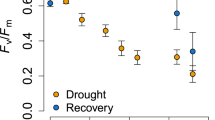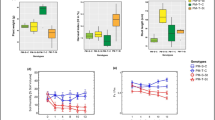Abstract
Root exudates were collected over a 27 day period from defoliated and non-defoliated Lolium perenne L. plants grown under sterile conditions in microlysimeters. Eleven individual sugars, including both aldehyde and alcohol sugars, were identified and quantified with a gas chromatograph-mass spectrometer (GC-MS). There was no change in the number of sugars present between 7 and 27 days, but the exudation of alcohol sugars decreased rapidly at about day 12. Xylose and glucose were present in the largest amounts. Defoliation initially increased the total amount of sugars in the exudates, but continuous defoliation reduced total sugar exudation by 16% and induced changes in the exudation patterns of individual sugars. Defoliation enhanced exudation of erythritol, threitol, and xylitol, reduced exudation of glucose and arabitol, but had little effect on the amounts of other sugars exuded. The more complex 6 C, 5 OH aldehyde sugars, especially glucose, showed changes earlier and to a greater extent (17 days), than the 5 C, 4 OH (xylose and ribose) and 6 C 4 OH (fucose) aldehyde groups. These findings confirm the general finding that repeated defoliation reduces the quantity of total sugars exuded, but the pattern of release of individual sugars is complex and variable.




Similar content being viewed by others
References
Clayton, S. J. 2003. Carbon Reallocation in Grasslands Under Stress. Ph.D. Thesis. The University of Reading, Reading.
Clement, C. R., Hopper, M. J., Jones, L. H. P., and Leafe, E. L. 1978. The uptake of nitrate by Lolium perenne from flowing nutrient solution 11. Effect of light, defoliation, and relationship to CO2 flux. J. Exp. Bot. 29:1173–1183.
De Visser, R. D., Vianden, H., and Schnyder, H. 1997. Kinetics and relative significance of remobilized and current C and N incorporation in leaf and root growth zones of Lolium perenne after defoliation: assessment by 13C and 15N steady-state labelling. Plant, Cell Environ. 20:37–46.
Deane-Drummond, C. E. 1986. Nitrate uptake into Pisum sativum L.cv. Feltham first seedlings: commonality with nitrate uptake into Chara corallina and Hordeum vulgare through a substrate cycling model. Plant, Cell Environ. 9:41–48.
Fulkerson, W. J., and Slack, K. 1994. Leaf number as a criterion for determining defoliation time for Lolium perenne.1. Effect of water-soluble carbohydrates and senescence. Grass Forage Sci. 49:373–377.
Grayston, S. J., Vaughan, D., and Jones, D. 1996. Rhizosphere carbon flow in trees, in comparison with annual plants: the importance of root exudation and its impact on microbial activity and nutrient availability. Appl. Soil Ecol. 5:29–56.
Greenaway, W., Scaysbrook, T., and Whatley, F. R. 1987. The analysis of bud exudate of populus x euramericana, and of propolis, by gas chromatography. Proc. Roy. Soc. London 232:249–272.
Guerrand, D., Prud’homme, M. P., and Boucaud, J. 1996. Fructan metabolism in expanding leaves, mature leaf sheaths and mature leaf blades of Lolium perenne. Fructan synthesis, fructosyltransferase and invertase activities. New Phytol. 134:205–214.
Haller, T., and Stolp, H. 1985. Quantitative estimation of root exudation of maize plants. Plant Soil 86:207–216.
Hoagland, D. R. and Arnon, D. I. 1950. The water culture method for growing plants without soil. California Agricultural Experimental Circular No. 347.
Hodge, A., Grayston, S. J., and Ord, B. G. 1996. A novel method for characterisation and quantification of plant root exudates. Plant Soil 184:97–104.
Holland, J. N. 1995. Effects of above-ground herivory on microbial biomass in conventional and no-tillage agrosystems. Appl. Soil Ecol. 2:275–279.
Johansson, G. 1993. Carbon distribution in grass (Festuca pratensis L.) during regrowth after cutting-utilization of stored and newly assimilated carbon. Plant Soil 15:11–20.
Jones, D. L., and Darrah, P. R. 1992. Re-sorption of organic components by roots of Zea mays. L and its consequences in the rhizosphere. Plant Soil 143:259–266.
Killham, K. 1994. Soil Ecology. Cambridge University Press, Cambridge.
Killham, K., and Yeomans, C. 2001. Rhizosphere carbon flow measurement and implications: from isotopes to reporter genes. Plant Soil 232:91–96.
Klein, D. A., Frederick, B. A., Biondini, M., and Trlica, M. J. 1988. Rhizosphere microorganism effects on soluble amino acids, sugars and organic acids in the root zone of Agropyron cristatum, A. smithii and Bouteloua gracilis. Plant Soil 110:19–25.
Lynch, J. M., and Whipps, J. M. 1990. Substrate flow in the rhizosphere. Plant Soil 129:1–10.
Macduff, J. H., and Jackson, S. B. 1992. Influx and efflux of nitrate and ammonium in Italian ryegrass and white clover roots: comparisons between effects of darkness and defoliation. J. Exp. Bot. 249:525–535.
Mawdsley, J. L., and Bardgett, R. D. 1997. Continuous defoliation of perennial ryegrass (Lolium perenne) and white clover (Trifolium repens) and associated changes in the composition and activity of the microbial population of an upland grassland soil. Biol Fertil. Soils 24:52–58.
Mcnaughton, S. J., Banyikwa, F. F., and Mcnaughton, M. M. 1998. Root biomass and productivity in a grazing ecosystem: Serengeti. Ecol. 79:587–592.
Meharg, A. A., and Killham, K. 1995. Loss of exudates from roots of perennial ryegrass with a range of microorganisms. Plant Soil 170:345–349.
Merbach, W., Mirus, E., Knof, G., Remus, R., Ruppel, S., Russow, R., Gransee, A., and Schulze, J. 1999. Release of carbon and nitrogen compounds by plant roots and their possible ecological importance. J Plant Nutr. Soil Sci. 162:373–383.
Mikola, J., Yeates, G. W., Wardle, D. A., Barker, G. M., and Bonner, K. I. 2001. Response of soil food-web structure to defoliation of different plant species combination in an experimental grassland community. Soil Biol. Biochem. 33:205–214.
Milchunas, D. G., and Lauenroth, W. K. 1993. Quantitative effects of grazing on vegetation and soils over a global range of environments. Ecol. Monographs 63:327–366.
Morvan-Bertrand, A., Pavis, A. N., Boucaud, J., and Prud’homme, M. P. 1999. Partitioning of reserve and newly assimilated carbon in roots and leaf tissues of Lolium perenne during regrowth after defoliation: by 13 C steady state labelling and carbohydrate analysis. Plant Cell Environ. 22:1097–1108.
Murray, P. J., Hatch, D. J., and Cliquet, J. B. 1996. Impact of insect root herbivory on the growth and nitrogen and carbon contents of white clover (Trifolium repens) seedlings. Canad. J. Bot. 74:1591–1595.
Murray, P. J., Dawson, L. A., and Grayston, S. J. 2002. Influence of root herbivory on growth response and carbon assimilation by white clover plants. Appl. Soil Ecol. 20:97–105.
Oades, J. M. 1967. Gas-liquid chromatography of alditol acetates and its application to the analysis of sugars in complex hydrolysates. J. Chromatog. 28:246–252.
Osborn, H. M. I., Lochey, F., Mosley, L., and Read, D. 1999. Analysis of polysaccharides and monosaccharides in the root mucilage of maize (Zea mays L.) by gas chromatography. J. Chromatog. A 831:267–276.
Ostle, N., Whiteley, A. S., Bailey, M. J., Sleep, D., Ineson, P., and Manefield, M. 2003. Active microbial RNA turnover in a grassland soil estimated using a 13CO2 spike. Soil Biol. Biochem. 35:877–885.
Paterson, E. 2003. Importance of rhizodeposition in the coupling of plant and microbial productivity. Europ. J. Soil Sci. 54:741–750.
Paterson, E., and Sim, A. 1999. Rhizodeposition and C-partitioning of Lolium perenne in axenic culture affected by nitrogen and defoliation. Plant Soil 216:155–164.
Paterson, E., Hodge, A., Thornton, B., Millard, P., and Killham, K. 1999. Carbon partitioning and rhziosphere C-flow in Lolium perenne as affected by CO2 concentration, irradiance and below-ground conditions. Global Change Biol. 5:669–678.
Paterson, E., Thornton, B., Midwood, A. J., and Sim, A. 2005. Defoliation alters the relative contributions of recent and non-recent assimilate to root exudation from Festuca rubra. Plant Cell Environ. 28:1525–1533.
Pollock, C., Farrar, J., Tomas, D., Gallagher, J., Lu, C., and Koroleva, O. 2003. Balancing supply and demand: the spatial regulation of carbon metabolism in grass and cereal leaves. J. Exp. Bot. 54:489–494.
Read, D. B., and Gregory, P. J. 1997. Surface tension and viscosity of axenic maize and lupin root mucilages. New Phytol. 137:623–628.
Sokal, R. R., and Rohlf, F. J. 1981. Biometry. New York, W H Freeman and Company.
Svenningsson, H., Sundin, P., and Liljenberg, C. 1990. Lipids, carbohydrates and amino acids exuded from the axenic roots of rape seedlings exposed to water-deficit stress. Plant Cell Environ. 13:155–162.
Veen, J. A. V., Merckx, R., and Geijn, S. C. 1989. Plant and soil related controls of the flow of carbon from roots through the soil microbial biomass. Plant Soil 115:179–188.
Wardle, D. A., Bonner, K. I., and Nicholson, K. S. 1997. Biodiversity and plant litter: experimental evidence which does not support the view that enhanced species richness improves ecosystem function. Oikos 79:247–258.
Widmer, F., Fliessbach, A., Laczko, E., Schulze-Aurich, J., and Zeyer, J. 2001. Assessing soil biological characteristics: a comparison of bulk soil community DNA-, PLFA-, and Biolog TM-analyses. Soil Biol. Biochem. 33:1029–1036.
Acknowledgements
This work was supported and jointly funded by the University of Reading and the Institute of Grassland and Environmental Research (IGER) North Wyke. North Wyke Research is grant funded by the Biotechnology and Biological Sciences Research Council of the UK.
Author information
Authors and Affiliations
Corresponding author
Rights and permissions
About this article
Cite this article
Clayton, S.J., Read, D.B., Murray, P.J. et al. Exudation of Alcohol and Aldehyde Sugars from Roots of Defoliated Lolium perenne L. Grown Under Sterile Conditions. J Chem Ecol 34, 1411–1421 (2008). https://doi.org/10.1007/s10886-008-9536-x
Received:
Revised:
Accepted:
Published:
Issue Date:
DOI: https://doi.org/10.1007/s10886-008-9536-x




